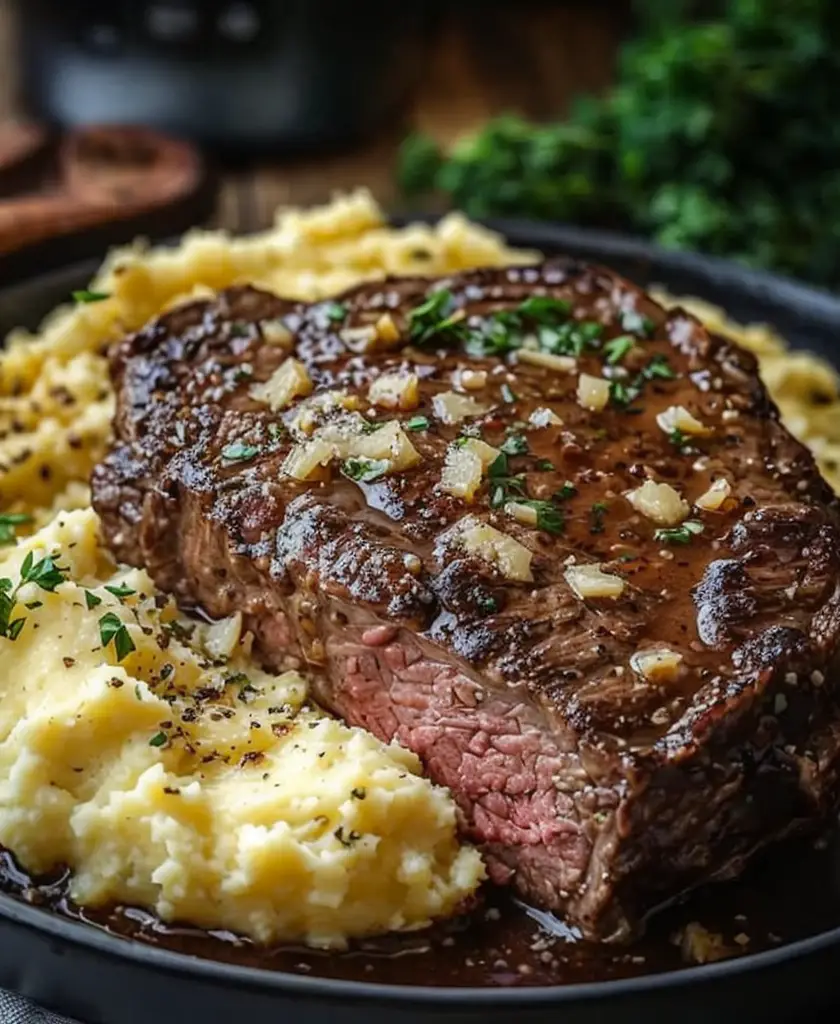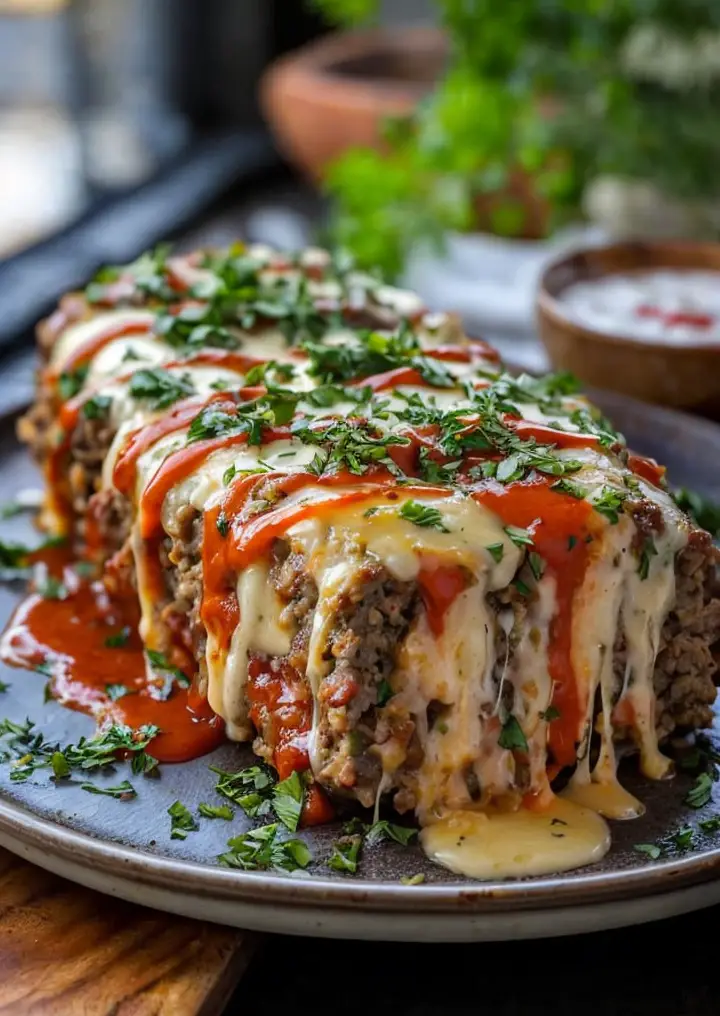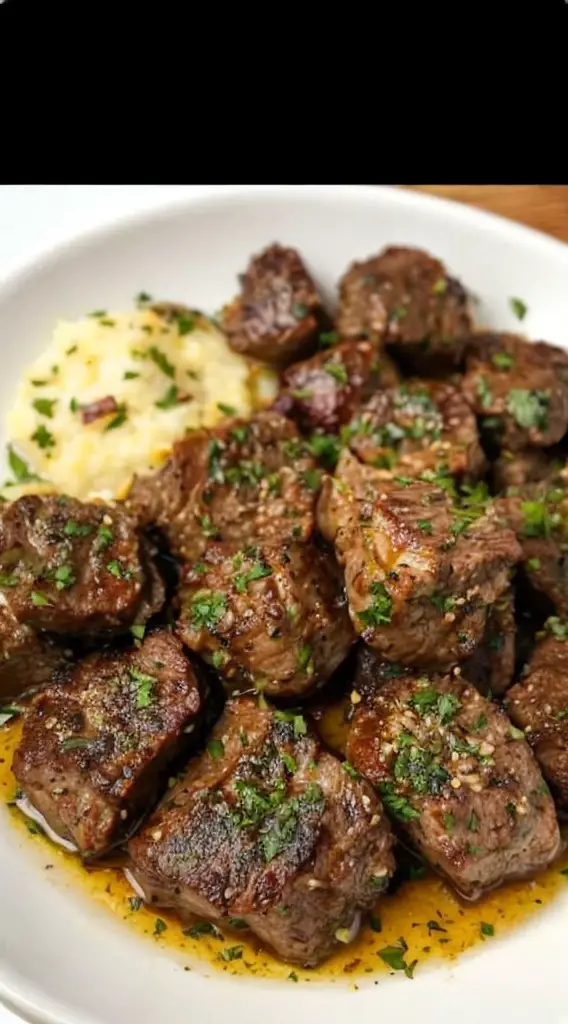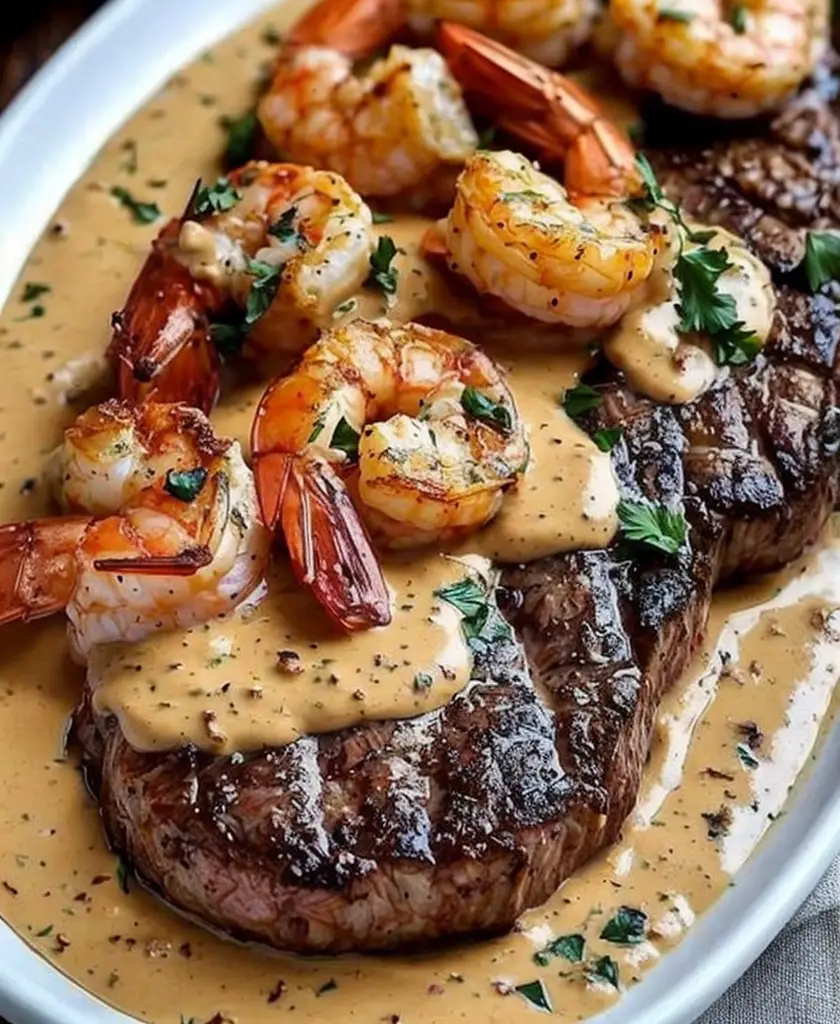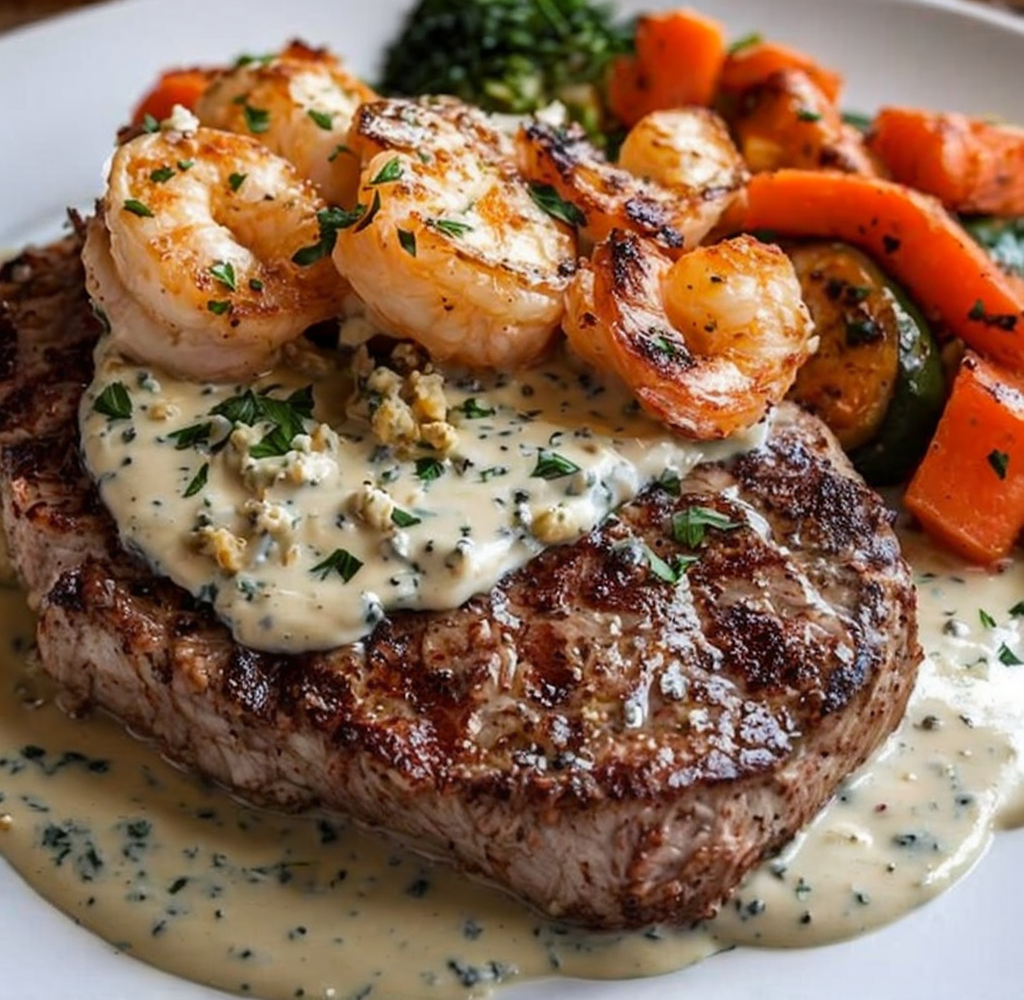Comforting Slow Cooker Garlic Butter Ribeye with Parmesan Mashed Potatoes: A Hearty Family Favorite
Indulge in the ultimate comfort food experience with our Comforting Slow Cooker Garlic Butter Ribeye with Parmesan Mashed Potatoes. This dish combines tender ribeye steak slow-cooked to perfection, infused with the rich flavors of garlic and creamy butter, creating an incredibly flavorful meal that is sure to please anyone at the dinner table. Paired with velvety Parmesan mashed potatoes, this recipe is not just food—it’s a warm embrace that soothes the soul.
Slow cooking this ribeye allows the marbled fat to melt away, enriching the meat’s natural juices while blending with fragrant herbs and spices. The result is a buttery, garlicky delight that falls apart with a fork. Meanwhile, the Parmesan mashed potatoes offer a dreamy texture, bringing an irresistible savory note that complements the beef beautifully. This dish is perfect for family gatherings, game day festivities, or simply enjoying a quiet evening at home.
Quick Recipe Highlights
- Flavor Profile: This dish features a delightful combination of savory garlic and creamy butter that infuses every bite of the ribeye while the Parmesan adds an extra layer of richness to the mashed potatoes.
- Texture: The ribeye steak becomes incredibly tender and juicy from slow cooking, while the mashed potatoes are luxuriously smooth and creamy.
- Aroma: The tantalizing scent of garlic wafts through your home as the ribeye cooks, ensuring everyone’s anticipation builds to a delicious crescendo.
- Visual Appeal: The beautifully browned ribeye, paired with fluffy white Parmesan mashed potatoes, creates an inviting and hearty plate.
- Skill Level Needed: This is an easy recipe suitable for beginner cooks, as the slow cooker does most of the work for you.
- Special Equipment: A slow cooker is essential for this recipe, along with a potato masher for the mashed potatoes.
Recipe Overview
- Difficulty Level: This Comforting Slow Cooker Garlic Butter Ribeye is classified as easy, making it perfect for cooks of all levels. The slow cooker takes the pressure off, allowing you to enjoy more time with family and friends.
- Category: This recipe falls under comfort food, ideal for cozy family dinners or gatherings with friends.
- Cuisine: This dish reflects a classic American culinary tradition, enriched with flavorful, hearty ingredients that symbolize warmth and home-cooked meals.
- Cost: With just a few affordable ingredients, this recipe offers great value while delivering a luxurious dining experience at home.
- Season: Best enjoyed in cooler months, this dish warms the heart and body, perfect for fall and winter feasts.
- Occasion: Serve it for family dinners, holiday gatherings, or even casual get-togethers to impress your guests with minimal effort.
Why You’ll Love This Recipe
Experience a taste and texture appeal with each bite of this Comforting Slow Cooker Garlic Butter Ribeye. The savory flavors meld beautifully with the luxurious mouthfeel of the mashed potatoes, making every meal a culinary delight. The tenderness of the ribeye, cooked low and slow, creates a juicy, melt-in-your-mouth experience that is simply irresistible.
Convenience shines through this recipe as it requires minimal active cooking time. Just prepare the ingredients, set your slow cooker, and allow it to do the work while you relax or attend to your guests. This recipe is perfect for busy weeknights or special occasions where quality matters but time is of the essence.
From a nutritional standpoint, ribeye steak is a good source of protein and essential nutrients, making it a fulfilling meal option. Pairing it with Parmesan mashed potatoes adds wholesome carbohydrates, offering a complete and satisfying dinner.
The social and entertaining value of this dish is undeniable. Friends and family will gather around the table, sharing stories and laughter while enjoying this hearty, home-cooked meal that brings everyone together.
Lastly, the cost-effectiveness of slow cooking is a significant advantage. Using less expensive cuts of beef becomes a flavorful masterpiece, allowing you to serve an impressive dinner without breaking the bank.
Historical Background and Cultural Significance
The origin of ribeye steak can be traced back to the early days of American cattle ranching, where it became popular due to its marbling and tenderness. This cut is revered by meat lovers for its rich flavor, making it a staple in American cuisine that epitomizes comfort food.
Culturally, this dish is representative of family gatherings, home cooking, and traditional meals shared around the dinner table. It has evolved into a beloved comfort food that resonates with generations, reminding us of the warmth of home and the joy of sharing food with loved ones.
As this recipe has evolved, various adaptations have emerged, particularly in how seasoned chefs and home cooks introduce unique elements, such as different herbs or side dishes. The integration of garlic butter into the cooking process adds a modern twist while maintaining the dish’s rustic roots.
Regional variations of ribeye dishes can be found across America, with each area embracing local flavors and ingredients. From BBQ-style preparations in the South to gourmet renditions in urban settings, ribeye steak remains a cherished component of American culinary identity.
Ingredient Deep Dive
For the ribeye steak, sourcing high-quality meat is crucial for achieving the best flavor. Ribeye is known for its rich marbling, which enhances its juicy texture. When selecting ribeye, look for well-marbled cuts with a vibrant red color and a good amount of fat surrounding the steak for that melt-in-your-mouth experience. Store raw ribeye in the refrigerator for up to three days or freeze for longer storage.
Garlic is another vital ingredient that brings depth to the dish. Rich in flavor and health benefits, it has been used in various cuisines for centuries. Garlic not only elevates the ribeye’s taste but also offers numerous nutritional advantages, including enhanced immune function. Choosing fresh garlic bulbs is paramount; store them in a cool, dark place.
Parmesan cheese adds a delightful creaminess to mashed potatoes, ensuring they are exceptionally savory. Aged for many months, Parmesan is known for its complex flavor, making it a popular choice in Italian and American dishes alike. When selecting Parmesan, opt for a block over pre-grated options to maintain freshness. Parmesan should be stored in the fridge, tightly wrapped to prevent moisture absorption.
Common Mistakes to Avoid
- Overcooking the Ribeye: The key to tender steak lies in cooking it just until it reaches your desired doneness. Overcooking can lead to dryness.
- Ignoring Marinade Time: Allowing the steak to marinate for at least an hour enhances flavor significantly; otherwise, it may taste bland.
- Skimping on Seasoning: Properly seasoning the ribeye before cooking brings out its natural flavors; don’t shy away from salt and pepper.
- Using Cold Ingredients: Letting the ribeye sit at room temperature for about 30 minutes before cooking ensures even cooking.
- Not Preparing Mashed Potatoes Correctly: Failing to adequately drain the potatoes before mashing can result in watery consistency.
- Neglecting to Taste as You Go: Not tasting the dish throughout the cooking process may lead to an imbalance of flavors.
- Rushing the Cooking Process: Slow cooking is key for developing flavors; don’t attempt to speed it up by raising the temperature.
- Overloading the Slow Cooker: Too much meat or vegetables can hinder proper cooking; ensure there’s enough room for steam circulation.
Essential Techniques
One essential technique for this recipe is marinating the ribeye. This process allows the flavors to penetrate the meat, enhancing overall taste. To master marinating, be sure to coat the steak evenly and let it sit for several hours or overnight. Avoid common pitfalls like using an acidic marinade for too long, which can lead to a mushy texture. Look for visual cues such as a deeper color to ensure effective marination.
Another critical technique is properly mashing the potatoes. Start by boiling peeled potatoes until fork-tender, then drain well. Use a potato masher or ricer for optimal texture. Over-mixing can cause a gummy consistency, so mash just until smooth. A visual cue for success is a creamy, fluffy texture without lumps.
Pro Tips for Perfect Comforting Slow Cooker Garlic Butter Ribeye
1. Choose a well-marbled ribeye for maximum flavor and tenderness during slow cooking. Look for bright red coloration and minimal connective tissue.
2. Allow the ribeye to come to room temperature before cooking for even doneness throughout the steak.
3. Don’t rush the cooking time; low and slow is the mantra for achieving tender, flavorful results.
4. Use fresh ingredients for the best taste; fresh garlic packs a more pungent punch than powdered alternatives.
5. For a richer flavor, add additional herbs like thyme or rosemary to the slow cooker.
6. Taste the sauce before serving and adjust seasoning as needed for a perfectly balanced dish.
7. If using leftovers, store them properly to maintain quality and flavor when reheating.
8. Pair the dish with a simple side salad to add freshness and color to your meal.
Variations and Adaptations
For a regional variation, consider adding South American spices like chimichurri to the ribeye for a flavorful twist. If you prefer a seasonal adaptation, incorporating root vegetables like carrots or parsnips into the slow cooker can add nutrition and flavor depth during the winter months.
In terms of dietary modifications, those needing gluten-free options can confidently enjoy this dish as all ingredients do not contain gluten. For those looking to reduce carbs, substitute traditional mashed potatoes with cauliflower mash, maintaining a creamy texture while lowering calories.
Flavor variations can include adding a splash of soy sauce for an umami kick in the ribeye marinade. To modify the texture, consider finishing the mashed potatoes with a touch of cream cheese for added thickness. Lastly, consider garnishing your dish with freshly chopped parsley to brighten the visual presentation.
Serving and Presentation Guide
When serving this delicious Comforting Slow Cooker Garlic Butter Ribeye, consider plating the dish on a rustic wooden board for a homey feel. Use a large spoon to artfully arrange the Parmesan mashed potatoes beside the ribeye, allowing the juices to mingle beautifully.
Garnish with fresh herbs like parsley or chives for an added splash of color and flavor, making the dish visually appealing. Accompany your meal with warm bread or a simple side salad to provide balance. Ensure to serve at an optimal temperature, letting the ribeye rest for about five minutes before cutting to retain its juices.
In terms of portion control, serve generous portions, especially if you know your guests love a hearty meal; adjust based on the occasion. Remember, the presentation is essential—serving on colorful plates enhances the meal’s overall aesthetic.
Wine and Beverage Pairing
For an exquisite wine pairing, consider a bold Cabernet Sauvignon or a rich Malbec, which complements the flavors of the ribeye splendidly. These wines bring out the dish’s savory notes without overwhelming the palate.
If you prefer a non-alcoholic option, a sparkling grape juice or a robust iced tea can offer refreshing balance alongside the rich flavors of your meal. Optionally, serve brewed coffee or a dark roast espresso for a delightful end to the meal; the bitterness will contrast nicely with the savory dish.
Temperature considerations are vital; serve red wines at room temperature while white wines should be chilled. For coffee or tea, ensure they’re served hot to enhance the overall dining experience.
Storage and Shelf Life
To ensure your Comforting Slow Cooker Garlic Butter Ribeye remains fresh, store leftovers in an airtight container in the refrigerator for up to three days. For best quality, reheat in the oven to maintain the ribeye’s tenderness.
If you need to freeze portions, ensure the ribeye is cool, then wrap it tightly in plastic wrap before placing it in a freezer-safe bag. The stew can last up to three months; however, it’s best consumed fresh for flavor.
Signs of spoilage include an off smell or discoloration. When reheating, ensure it reaches the internal temperature of 165°F for safety. Always thaw in the refrigerator overnight before reheating to maintain quality.
Make Ahead Strategies
To simplify meal prep, consider marinating the ribeye the night before to enhance flavor significantly. Store it in the refrigerator, allowing the garlic and butter to permeate the meat while you rest.
You can also prepare the parmesan mashed potatoes in advance. Simply boil and mash the potatoes, then cool them down before refrigerating. When it’s mealtime, reheat them gently on the stove, adding a splash of cream to revive their creamy texture.
Evaluate quality when combining steps; avoid allowing the ribeye to sit in marinade for more than 24 hours to prevent unwanted texture changes.
Scaling Instructions
If you need to halve the recipe, adjust cooking time by checking for doneness 1 hour earlier than the original timing. It is straightforward to double or triple the ingredients, but ensure your slow cooker can accommodate the increased volume without overcrowding.
When scaling, maintain the same ratio of marinating ingredients for consistent flavor. Equipment adjustment may be necessary if doubling, ensuring that the slow cooker is large enough to contain all ingredients.
Timing modifications may be required based on portion size; larger quantities can take longer to reach a safe internal temperature. Monitor the dish as you adjust cooking time, taking care that ingredients are evenly distributed to cook properly.
Nutritional Deep Dive
The macro breakdown for a serving of Comforting Slow Cooker Garlic Butter Ribeye includes substantial protein from the ribeye steak, essential for muscle maintenance and repair. Pairing it with mashed potatoes offers carbohydrates, providing energy, which is especially beneficial for active individuals.
Micronutrient analysis reveals this dish is rich in vitamin B12 and iron from the ribeye, crucial for blood health, while the Parmesan contributes calcium for strong bones. Adding garlic enhances flavor and offers anti-inflammatory properties.
When considering dietary considerations, keep portion sizes consistent with individual nutrient needs. Weight management tips may include serving smaller portions of ribeye and bulk up with additional vegetables for balanced nutrition.
Dietary Adaptations
For a gluten-free adaptation of this dish, ensure that any sauces used are free of gluten-containing products. This recipe is inherently gluten-free, making it suitable for those with gluten sensitivities.
To create a dairy-free version, substitute the Parmesan cheese with a nut-based cheese alternative and use plant-based butter in the mashed potatoes for a similar creamy texture and flavor profile.
For those following low-carb, Keto, or Paleo diets, modifications can include replacing mashed potatoes with cauliflower mash or zucchini noodles while limiting additional starches.
Troubleshooting Guide
If experiencing texture issues with the ribeye, ensure the slow cooker wasn’t too crowded as it can affect cooking times; slight adjustments may be necessary depending on your appliance.
In the event of flavor imbalance, taste the dish periodically during cooking and adjust seasonings; under-seasoning is a common problem that can easily be remedied.
Should your potatoes appear too watery, ensure they are adequately drained after boiling, and consider using a ricer for fluffier results.
If the meat has become dry, overcooking is a likely culprit; always check for doneness towards the lower end of cooking times.
Recipe Success Stories
Our readers have raved about this Comforting Slow Cooker Garlic Butter Ribeye, sharing stories of their successful family dinners. Many have noted how the aroma filled their homes, creating a warm atmosphere that invited their loved ones to the table.
Several community members have experimented with flavors, infusing Asian-inspired ingredients like ginger into the marinade, garnering praise from family and friends. They’ve reported these variations spark new conversations at the dinner table, showcasing the dish’s adaptability to different palates.
Photography tips have also been shared, encouraging home cooks to capture their creations, showing off the beautiful plating and enjoy the compliments received for their culinary skills.
Frequently Asked Questions
Can I cook this recipe on high in the slow cooker?
While it’s possible to cook on high, doing so may alter the steak’s texture. To achieve the best results, slow cooking on low is recommended to ensure the meat remains tender and flavorful.
What can I substitute for Parmesan cheese?
If you’re looking for alternatives, consider Pecorino Romano for a similar sharp flavor or nutritional yeast for a dairy-free option that adds umami without cheese.
How should I store leftovers?
Leftovers can be stored in an airtight container in the refrigerator for up to three days. For longer storage, freeze portions wrapped tightly.
Can I use another cut of beef?
While ribeye offers the best flavor and tenderness, cuts like chuck roast or sirloin can work as well, altering the cooking time and texture slightly.
Can this dish be made ahead of time?
Yes! You can marinate the ribeye a night before and cook it the next day. The mashed potatoes can also be prepared in advance and reheated.
What should I serve with this dish?
This dish pairs wonderfully with a simple side salad, crusty bread, or roasted vegetables that complement the rich flavors of the ribeye.
Can I cook this recipe in the oven instead of a slow cooker?
Yes! You can prepare the ribeye in the oven using a covered roasting pan, but cooking time will vary. Monitor it to ensure proper doneness.
What type of potatoes are best for mashed potatoes?
Uniformly starchy potatoes like Russets or Yukon Golds are ideal for making creamy mashed potatoes, as they break down nicely and create a smooth texture.
How spicy is this recipe?
This recipe is not inherently spicy, but feel free to add red pepper flakes or fresh chili to the marinade to introduce heat if desired.
Can I make this dish in an Instant Pot?
Yes! You can adjust the cooking time and pressure settings to make this recipe in an Instant Pot, but keep in mind the texture may vary compared to slow cooking.
Additional Resources
For further culinary exploration, check out other related recipes like Slow Cooker Beef Stroganoff or Classic Beef Short Ribs. These recipes also utilize slow cooking techniques, ensuring rich dishes with minimal effort.
Dive into technique guides that offer insights on perfectly cooking beef, mastering mashed potatoes, or slow-cooker tips. Understanding these skills will enhance your overall cooking experience.
For ingredient information, consider resources detailing various cuts of beef, how to select the freshest produce, or the health benefits of key ingredients.
Explore equipment recommendations, particularly for slow cookers and kitchen essentials that enhance the cooking process for various recipes.
If you’re keen on seasonal variations, take advantage of fresh ingredients available during specific months, adapting your meals to incorporate local produce.
Join the Conversation
Engage with our community by sharing your photos and experiences while making this dish on social media. Tag us to showcase your culinary creations and inspire others.
Leave a review or comment sharing your thoughts or any variations you tried. Our audience loves hearing about personal successes and new flavors that elevate this classic dish.
Connect with fellow food enthusiasts, share tips or suggestions on how to improve or adapt the recipe. Your contributions could inspire someone else’s cooking journey!
The Recipe
Comforting Slow Cooker Garlic Butter Ribeye with Parmesan Mashed Potatoes
Serves: 4 servings
Prep Time: 15 mins
Cook Time: 8 hours
Total Time: 8 hours 15 mins
Kitchen Equipment Needed
- Slow cooker
- Potato masher
- Cutting board
- Sharp knife
- Measuring cups and spoons
Ingredients
- 2 pounds ribeye steak
- 4 tablespoons garlic butter
- 3 cloves garlic, minced
- Salt and pepper, to taste
- 2 pounds potatoes, peeled and cubed
- ½ cup grated Parmesan cheese
- ½ cup heavy cream
- 2 tablespoons butter
Directions
- Season the ribeye steak generously with salt and pepper. In a skillet, sear both sides until browned, about 3-4 minutes.
- Place the seared ribeye in the slow cooker along with garlic and garlic butter. Cover and cook on low for 8 hours.
- During the last hour of slow cooking, boil the potatoes in salted water until tender, about 15-20 minutes; drain well.
- Mash the potatoes with butter and heavy cream until creamy. Stir in Parmesan cheese until well combined.
- Once the ribeye is tender, shred the meat with a fork and serve it alongside the Parmesan mashed potatoes.
Recipe Notes
- For added flavor, consider adding rosemary or thyme to the ribeye during cooking.
- Feel free to substitute different types of cheese in the mashed potatoes for varied flavors.
- Leftover mashed potatoes can be made into potato cakes; simply pan-fry with butter until crispy.
